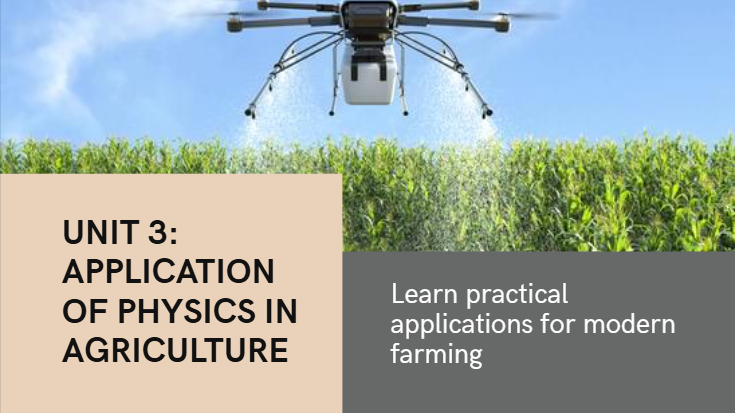PHYSICS S6 UNIT 3: APPLICATION OF PHYSICS IN AGRICULTURE.

About Course
Physics plays a fundamental and increasingly vital role in modern agriculture, impacting everything from soil management to advanced farming technologies. The application of physical principles in agriculture is often referred to as Agrophysics. Here’s a breakdown of its key applications:
I. Soil Physics
Understanding the physical properties of soil is crucial for optimizing plant growth and managing resources effectively.
-
Soil Structure and Texture: Physics helps characterize soil composition (sand, silt, clay percentages) and structure (arrangement of particles), which in turn dictate water infiltration, aeration, and root penetration.
-
Soil Water Dynamics:
-
Water Retention: Principles of capillary action and surface tension explain how soil holds water against gravity. This is critical for irrigation scheduling and ensuring water availability to plants.
-
Water Movement: Physics describes water flow in saturated and unsaturated soils, including infiltration, percolation, and evapotranspiration. This knowledge is vital for efficient irrigation design (e.g., drip irrigation, sprinkler systems).
-
Soil Water Potential: Quantifies the energy status of water in the soil, indicating its availability to plants. Sensors based on physical principles measure this potential to guide irrigation.
-
-
Soil Thermal Properties: Heat transfer (conduction, convection, radiation) in soil affects seed germination, root growth, and microbial activity. Physics helps understand soil temperature fluctuations and design strategies for temperature management (e.g., mulching).
-
Soil Aeration and Gas Exchange: The movement of air and gases (like oxygen and carbon dioxide) within the soil is governed by diffusion and mass flow, physical processes essential for root respiration and nutrient cycling.
-
Soil Compaction: Understanding the mechanical properties of soil helps in designing farm machinery to minimize compaction, which can impede root growth and water infiltration.
II. Plant Physics (Plant Physiology & Growth).
Physics governs how plants interact with their environment and utilize resources.
-
Photosynthesis: Light energy is converted into chemical energy. Physics helps in understanding light quality, intensity, and duration, which are crucial for optimizing plant growth, especially in controlled environments like greenhouses (e.g., using LED grow lights with specific light spectra).
-
Water Transport (Transpiration): The movement of water from roots to leaves and its evaporation from stomata is a physical process driven by water potential gradients and atmospheric conditions. Physics helps quantify evapotranspiration for efficient irrigation.
-
Nutrient Uptake: The movement of nutrients from soil to roots involves diffusion and mass flow, governed by physical laws.
-
Plant Architecture and Mechanics: The physical properties of plant stems, leaves, and fruits (e.g., strength, elasticity) influence their resilience to wind, rain, and mechanical harvesting.
-
Remote Sensing: Satellites and drones equipped with sensors (using principles of electromagnetism and optics) measure light reflectance from crops to assess plant health, nutrient deficiencies, and water stress, enabling precision farming.
III. Agricultural Machinery and Engineering
Physics is at the core of designing, operating, and optimizing farm equipment.
-
Mechanics: Principles of forces, motion, friction, and torque are applied in the design of tractors, plows, harvesters, and other machinery to ensure efficiency, stability, and safety.
-
Fluid Dynamics: Understanding the flow of liquids (e.g., water in irrigation systems, pesticides in sprayers) and gases (e.g., air in ventilation systems for livestock or storage) is based on fluid mechanics.
-
Thermodynamics: Applied in designing heating and cooling systems for greenhouses, animal shelters, and food storage facilities.
-
Automation and Robotics: Modern farming utilizes principles of robotics, control systems, and sensor technology (all rooted in physics) for automated planting, harvesting, and pest control.
-
Precision Agriculture: GPS technology, sensors, and variable rate applicators (all physics-based) allow farmers to apply inputs (water, fertilizer, pesticides) precisely where and when needed, optimizing resource use and reducing waste.
IV. Post-Harvest Management.
Physics plays a role in maintaining the quality and extending the shelf life of agricultural products.
-
Heat and Mass Transfer: Understanding how heat and moisture move in stored produce is vital for designing efficient drying, cooling, and storage systems to prevent spoilage.
-
Mechanical Properties of Produce: Knowledge of firmness, elasticity, and susceptibility to bruising helps in designing gentle handling and packaging systems.
-
Radiation Technologies: Gamma irradiation is used for pest control and extending the shelf life of certain foods, leveraging principles of nuclear physics.
V. Environmental Physics in Agriculture (Agro-meteorology & Sustainability).
-
Weather and Climate Monitoring: Physics underpins meteorological instruments (thermometers, barometers, anemometers) and models that predict weather patterns crucial for planting, harvesting, and pest management.
-
Energy Balance: Understanding the energy exchange between the Earth’s surface, plants, and the atmosphere (solar radiation, sensible heat, latent heat) is critical for water management and climate impact assessment.
-
Greenhouse Design: Principles of heat transfer, light transmission, and ventilation are applied to create optimal growing environments in greenhouses.
-
Renewable Energy in Agriculture: Physics is essential for harnessing solar, wind, and biomass energy for farm operations, contributing to sustainable agriculture.
-
Waste Management: Physical processes are involved in composting, anaerobic digestion, and other waste treatment methods to convert agricultural waste into valuable resources.
In essence, physics provides the fundamental principles that underpin most, if not all, modern agricultural practices and technologies. It helps farmers and researchers understand natural processes, design efficient tools, optimize resource use, and ultimately contribute to more productive and sustainable food systems.
Course Content
ATMOSPHERE AND ITS CONSTITUENTS.
-
Atmosphere.
11:41 -
Composition of the Atmosphere.
18:13 -
Layers of the Atmosphere.
17:47 -
Checking my Progress.
35:26
HEAT AND MASS TRANSFER.
PHYSICAL PROPERTIES OF SOIL.
MECHANICAL WEATHERING.
END UNIT ASSESSMENT
Final Unit Exam
Student Ratings & Reviews

